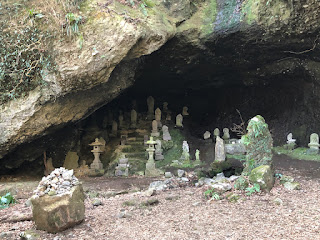--Susan, Every Other Sunday
It's safe to say most people have heard of samurai--the highly skilled warriors who sat atop the social pyramid during Japan's medieval age--as well as the shōgun(s) who served as the de facto rulers of the country at that time.
Far less well-known is the fact that, but for a split-second decision by a single, otherwise unremarkable little bird, the Age of Samurai might not have come to pass.
In 1180, a long-standing feud between the noble Taira and Minamoto clans boiled over into war. Shortly after the war began, a young nobleman named Minamoto no Yoritomo assumed leadership of the Minamoto forces and led them into battle in a mountainous region near the eastern coast of Japan, in what is now Shizuoka Prefecture.
 |
| A path through the mountains not far from Ishibashiyama |
The Taira launched a surprise attack on the Minamoto near Mt. Ishibashi (Ishibashiyama) at night, in heavy rain; the Minamoto forces were overwhelmed, and young Yoritomo was forced to flee with a small band of his surviving followers. They fled through the mountains toward the coast, hoping to escape by sea.
 |
| Kannon statue along the route to Shitodo |
The region into which they fled was controlled by a clan of noble warriors called the Doi; their leader, Doi Sanehira, had a castle on the summit of Shiroyama (Mt. Shiro) overlooking Sagami Bay (in what is now the city of Yugawara, in Shizuoka Prefecture, about 90 minutes south of Tokyo by train).
Minamoto Yoritomo and his followers hurried through the forested mountains, on narrow trails, with the Taira in hot pursuit.
.jpeg) |
| One of the trails connecting Ishibashiyama and Shiroyama |
 |
| Trail approaching the Shitodo cave |
Instead, Sanehira Doi directed Yoritomo and his followers to a small cave--today, called the Shitodo no Iwaya (Shitodo cave)--on the east side of Shiroyama, about half an hour's climb below the summit.
.jpeg) |
| Statues of Kannon, the Buddhist avatar of mercy, near the Shitodo cave |
Yoritomo and his little band took shelter in the cave.
 |
| Stairs leading up to the Shitodo |
The Taira approached the Doi, who of course claimed they had no idea where Minamoto no Yoritomo and his men had gone. The Taira proceeded to search Mt. Shiro, determined to destroy the young Minamoto leader (and, likely, win the war) while they had the chance.
 |
| More Buddhist statues outside the Shitodo. |


.jpeg)














An amazing story, Susan. It's the butterfly wing flapping theory in practice! Since neither the victors nor the vanquished come out of it looking good, I imagine we can accept that it's true.
ReplyDeleteLoved it, Susan. There are so many examples of where tides have turned on the smallest of events. "For want of a nail, the war was lost..."
ReplyDeleteOh I love this story, Susan!
ReplyDeleteA terrific tale, Susan, reminiscent of the biblical story of David (a later king), hotly pursued by King Saul, hiding in a cave where a small spider quickly spun a web across the entrance to the cave. Saul and his soldiers didn't bother to go into the cave, because they took the spider's web as a sign that no one had entered it. There's got to be an animated film in all of this somewhere.
ReplyDeleteHow beautiful, Susan. And I love the way the Japanese are so careful and enthusiastic in the way they preserve their history.
ReplyDelete